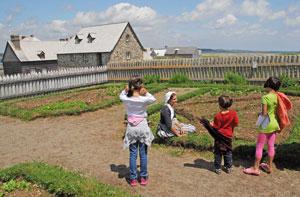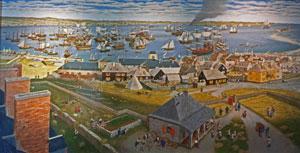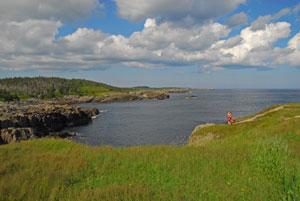The uniformed soldier stood with his shoulders squared and feet firmly planted, blocking our entry into the massive stone fortress. Musket in hand and sword hanging at his side, he issued a challenge in French, then switched to English when it was evident that was our native tongue. Our speech had raised suspicions that perhaps we were spies from the British colonies. Where were we from, what business did we have here?
The brief exchange quickly turned to good-natured banter with the costumed interpreter as he stood aside and welcomed us to Fortress of Louisbourg National Historic Park, but in the mid-1700s, there would have been no levity in questions from the French soldiers guarding these gates. There was ample reason for their caution--what lay inside was the most heavily fortified town on the Atlantic coast of North America.
Fortress of Louisbourg Isn't Well-Known to Most Americans
Many Americans aren't familiar with the Fortress of Louisbourg, but nearly three centuries ago this town within a wall in present-day Nova Scotia was one of the most important ports and military posts in North America. The enormous quantity of cargo shipped from Louisbourg was vital to the French economy, but the nature of that cargo might surprise you.
No, Louisbourg wasn't shipping out furs from the vast inland wilderness, timber from the seemingly endless forests, or precious metals such as silver or gold. This valuable cargo was dried fish...and a lot of it. In the early to mid-1700s, fish was a vital part of the food supply for the growing population in France, and the waters off what we now call Nova Scotia held incredible quantities of cod. Even though the year 1739 was reported to be a "bit down" in production, records show that 143,660 quintals (over 14 million pounds) of cod departed the docks of Louisbourg for points east and south in that one year alone.

Interpreters of all ages help recreate life here in 1740. Jim Burnett photo.
Today's Big Attraction is History, Not Fish
You can still find a fine seafood dinner in this area, but the big draws for present-day visitors are the impressive reconstruction and living history activities at Fortress of Louisbourg National Historic Site. If you visit the park, you'll be able to stroll through buildings and streets which represent about a quarter of the original fortress.
The British and French wrestled over control of this area for parts of two centuries, and the French were very serious about retaining this strategic site with its protected and ice-free harbor. Work on the fortress took most of three decades, and by the time it was completed, military engineers had supervised construction of two and a half miles of massive walls; in places they were 30 feet high and 36 feet thick.
The Gibralter of North America
The cost of constructing what some called the "Gibraltar of North America" was so great that that one source says the French king inquired "if its streets were paved with gold." Given the costs, it's not surprising that the fortress was named in honor of King Louis XIV.

Miles of massive stone walls surrounded the fortress. Jim Burnett photo.
When completed, this may have been the most impressed fortified city along the Atlantic coast, but the British still succeeded in capturing it in 1745, thanks to major help from troops from the New England colonies.
Those New Englanders were not pleased when, only three years later, a treaty restored the town to the French, so when the British recaptured Louisbourg once again in 1758, they made sure there would not be a third campaign against the fortress. They leveled it.
Some of the stone from the once proud walled town was transported to Boston to construct Louisbourg Square and other buildings in that city, and for the next two centuries, there wasn't much to see at the site of the original Louisbourg.
A Second Chance for Louisbourg
Louisbourg received a chance for revival in 1961, when the Government of Canada began a major project aimed at reconstructing approximately one-quarter of the original town and its fortifications. The result is said to be the largest historical reconstruction in Canada: it's definitely worth a visit.
At least one fellow tourist described this park as "the Canadian version of Colonial Williamsburg," and if you've ever visited that area, you'll have a pretty good mental picture of what takes place at Louisbourg, although on a somewhat smaller scale.
Things to Know for Your Visit
My wife and I arrived shortly after the park opened at 9 a.m. on a mid-July morning, intent on getting tickets for one of two daily conducted walking tours. A busload of tourists had arrived just ahead of us, so we ended up on the early afternoon guided walk, which was well worth 50 minutes of our time and a nominal fee.

The guided walking tour provides a good overview of the Louisbourg story. Jim Burnett photo.
There's no charge to park in a large lot near the visitor center, but you will pay an entrance fee before boarding a bus for the 5-minute ride to the historic area. The busses run at regular intervals during the peak visitor season, so take a few minutes in the museum/exhibit area to get an overview of the Louisbourg story.
Your entry fee allows you go and come between the historic town, the visitor center, and your car, but that's not very efficient use of your time, so my advice is to plan to be independent of your vehicle and anything in it for the duration of your visit. You're welcome to haul a picnic lunch, water bottles and other supplies with you if you wish, although there are several options for meals inside the fortress.
There's Plenty to See and Do
After disembarking from the shuttle bus, you're encouraged to make a short stop at a reconstructed fisherman's home and get the story about those all-important cod from a couple of costumed interpreters. A short stroll along the shoreline will then take you to the imposing stone walls of the fortress itself, and that brief and entertaining encounter with the guard at the gate. Once inside, there's plenty to occupy your time, so it's a good idea to check the printed schedule of activities which you were given at the visitor center.

The costumed "inhabitants" are glad to interrupt their work to talk with visitors of all ages. Jim Burnett photo.
You'll encounter plenty of costumed townspeople, both civilian and military, since a "fortress" is a fortified town, not just a military post. The staff does a fine job creating an atmosphere for learning about life in 1740 in an engaging manner.
At intervals during the day, the rattle of musket fire and boom of a cannon announce completion of weapons firing demonstrations, and the music of fifes and drums compete with the rattle of a cart down the street and the occasional bawl from a small herd of sheep.
Follow Your Nose to the King's Bakery
Louisbourg was a major port, so the smell of salt water is never far away, competing with the scent of wood smoke'and after one of those musket demonstrations'the brief, sharp odor of gunpowder. If you stroll past the corner of Rue de Petit Etang and Rue Royale, you'll likely get a whiff of bread baking in the oven at the King's Bakery, a subtle enticement to try the fare at one of several dining establishments within the town's walls.

This large painting depicts the busy harbor in 1740. Jim Burnett photo.
A number of buildings in the town have been furnished to help depict the life of the inhabitants, from the barracks of the lowliest soldiers to the home of a military officer and the Governor's Apartments.One of the most imposing residences is the "Engineer's Property," the home of the Royal Engineer.
Exhibits in several buildings help tell the story of Louisbourg; among the most effective are a scale model of the entire town and a collection of very large paintings which depict the harbor and town at the height of the area's prosperity.
Tour the Town With This Interactive Map
An interactive map at this link allows you to "travel" around the town; when your cursor hovers over selected structures, a separate window will open with photos and more information. If you'd like to see what's happening on one of the main streets in town right now, check out this webcam.
Our visit was on a weekday in July, and although the park was a bit busy, at no time did we feel it was overly crowded. Even during the mid-day meal hour, we had only a short wait for a table at Grandchamp's Tavern, which features "less formal dining" and a menu leaning toward the "lower class" inhabitants of the town. A more "upscale" menu was available next door at the Hôtel de la Marine, along with hot and cold beverages and snacks at L'Ãpée Royale Café.

A walking trail near the lighthouse offers fine views of the coastal lanscape. Jim Burnett photo.
Trails Showcase More Than History
If you decide you're ready for a change of pace from history, this park also offers six short walking trails outside the walls of the Fortress. Ranging in length from 0.1 miles to just under a mile and a half, all but one of these footpaths are located in the general vicinity of the Fortress, and offer a look at the area's natural features as well as the unreconstructed remains of the rest of the original 18th-century town.
One of these trails requires a fifteen-minute drive back out of the park itself through the modern small town of Louisbourg, so we saved it for the end of the day. It was well worth the short drive, and this side trip is a must-see for scenery and a different kind of history.
A Bonus Attraction Across the Harbor
The Louisbourg Lighthouse is located across the harbor from the Fortress and occupies the site of the first lighthouse built in Canada, in 1734. The present structure, the fourth to be built on this spot, dates to 1923, and it's a beauty. The lighthouse, which is located in the park, isn't open to visitors, but you're welcome to walk around it, and then enjoy the 1.28-mile round trip loop trail. This route offers outstanding coastal vistas, and interpretive panels provide information on the area's flora and fauna.
You'll find more details and driving directions at this link. For an excellent overview of the Fortress and activities in the park, click on the link below for a short video.
Accommodations and restaurants are located within a couple of miles of the park in the nearby modern community of Louisbourg, a pleasant small coastal village with a population of about 1,000. A wider range of places to stay and eat, along with an airport, are available 25 miles away in the town of Sydney, Nova Scotia.
If you haven't traveled in Canada recently, you'll find some tips for your cross-border trip in this story on the Traveler.
For the Full Experience, Come During the Summer Season
A full range of interpretive activities are available at Fortress of Louisbourg National Historic Park from July 1 to Labour Day (the first Monday in September), with limited activities offered during the shoulder season (mid-May through the end of June) and then September through the Canadian Thanksgiving Day (the second Monday in October.)You're welcome to wander through the town on your own (no services provided) the remainder of the year. You'll find details on days and hours of operations here.
Don't let that soldier at the gate dissuade you. He's a pushover for a friendly smile, and the Fortress of Louisbourg is definitely worth at least a day of your time.
Next Sunday on the Traveler: You'll find plenty of nostalgia and scenery at Prince Edward Island National Park.


 Support Essential Coverage of Essential Places
Support Essential Coverage of Essential Places







Add comment